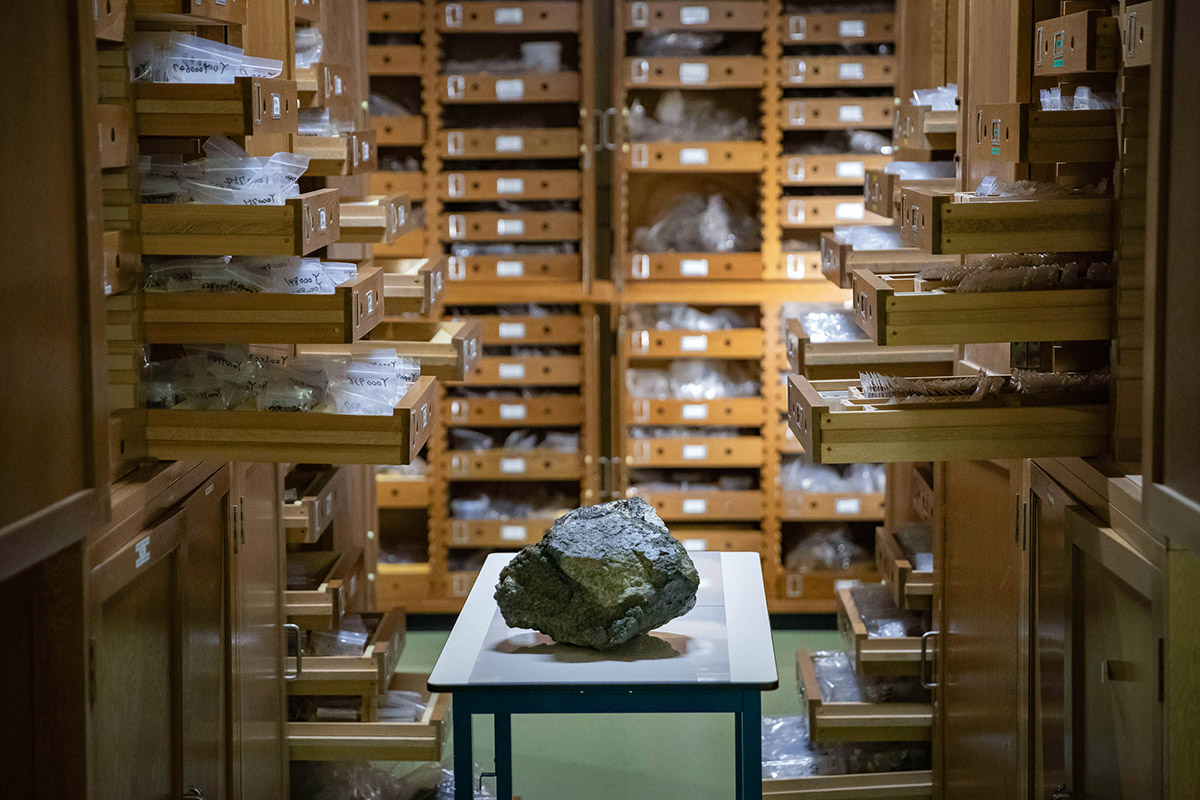National Institute of Polar Research
Japan’s Antarctic Meteorite Collection earns global recognition as IUGS Geo-collection
March 12,2025
Collection holds 17,400 meteorites
The Antarctic Meteorite Collection at the National Institute of Polar Research (NIPR) in Japan has been recognized as a Geo-collection by the International Union of Geological Sciences (IUGS). An IUGS Geo-collection is a museum collection of global importance because of its particularly high scientific, historical, or educational relevance for geological sciences. With over 17,400 meteorites, the Antarctic Meteorite Collection offers invaluable insights into the early solar system, planetary bodies, the Moon, and Mars. Carefully classified and stored, these samples complement space mission findings, advancing global research on planetary evolution and solar system history.

Title: Japanese Antarctic Meteorite Collection
Caption: The Antarctic Meteorite Collection at the National Institute of Polar Research in Japan houses 17,400 meteorites.
Image credit: Atsushi Takenouchi
License type: Original content
Image usage restrictions: News organizations may use or redistribute this image, with proper attribution, as part of news coverage of this paper only.
These meteorites play a unique role in advancing planetary science because they are minimally altered extraterrestrial samples. “Antarctic meteorites are invaluable for understanding the origins, evolution, and diversity of solar system materials. Their pristine preservation and wide variety offer unique insights into planetary formation and processes, highlighting their critical scientific, historical, and educational value,” said Associate Professor Akira Yamaguchi from NIPR.
Meteorites are solid fragments of extraterrestrial materials, larger than ~2 millimeter, that have traveled from space to land on the Earth. When they enter Earth's atmosphere, their surface experiences intense heat, causing the surface to melt and then solidify. This process results in a characteristic black fusion crust.
Many meteorites are unique in that their formation ages are commonly as old as 4.6 billion years. Earth's rocks never reach this age because of continuous igneous activity that occurs with plate tectonics. Because of their significant age, meteorites are among the most ancient materials available for scientific study.
Scientists believe that most meteorites originate from small bodies in the asteroid belt between the orbits of Mars and Jupiter. Large-scale volcanic activity does not occur in these small bodies, so they preserve their primitive nature and the formation age of the early solar system.
NIPR houses over 17,400 Antarctic meteorites, primarily recovered from blue ice fields near the Yamato and Sør Rondane Mountains during Japanese Antarctic research expeditions. In 1969, a Japanese Antarctic research expedition discovered nine meteorites while investigating the ice sheet near the Yamato Mountains. Since then, they have discovered 17,400 meteorites in 24 expeditions.
At NIPR, the Antarctic meteorites are classified, cataloged, and stored under strict clean-room conditions to minimize weathering. Researchers have classified more than 13,000 meteorites, with data shared globally. Originating from diverse bodies in the solar system, these samples complement space mission findings and advance the understanding of planetary evolution.
“The National Institute of Polar Research's mission as a shared-use facility has received international recognition, emphasizing its significant role in advancing planetary science through global collaboration. Being part of the inaugural designation by IUGS Geo-collection, alongside prestigious collections like the Vienna Natural History Museum, further underscores the exceptional value and importance of the Antarctic meteorite collection,” said Yamaguchi.
With its 17,400 meteorites, the Japanese Meteorite Collection is one of the largest collections of extraterrestrial material in the world. By distributing these meteorite samples to researchers all over the world, the organization contributes to the development of planetary sciences. Beyond their extensive collections, the Antarctic Meteorite Research Center actively collaborates with asteroid sample return missions and leading domestic and international research institutions to provide a comprehensive approach to the study of extraterrestrial materials.
Looking ahead, NIPR hopes to continue the detailed analysis of Antarctic meteorites, focusing on their mineralogical, petrological, chemical, and isotopic properties to uncover further insights into the early solar system's formation processes. NIPR also seeks to expand collaborative research and enhance the accessibility of these samples to the global scientific community. “The ultimate goal is to build a comprehensive understanding of solar system evolution, including the differentiation of planetesimals and the formation of planets, while preserving the scientific and educational value of Antarctic meteorite collections for future generations,” said Yamaguchi.
IUGS Geo-collection
An IUGS Geo-collection is a museum collection or part of a museum collection of global importance because of its particularly high scientific, historical, or educational relevance for geological sciences.
Antarctic Meteorite Research Center, National Institute of Polar Research
The Antarctic Meteorite Research Center stores meteorites collected by the Japanese Antarctic Research Expeditions. The total number of meteorites held is approximately 17,400 (including unregistered meteorites), making it one of the largest collections of extraterrestrial material in the world. By distributing these meteorite samples to researchers all over the world, the organization contributes to the development of planetary sciences. As well as our extensive collections, we actively collaborate with asteroid sample return missions and leading domestic and international research institutions to provide a comprehensive approach to the study of extraterrestrial materials.
- Website: https://yamato.nipr.ac.jp/english/
Media contact
e-mail: yamaguch@nipr.ac.jp








